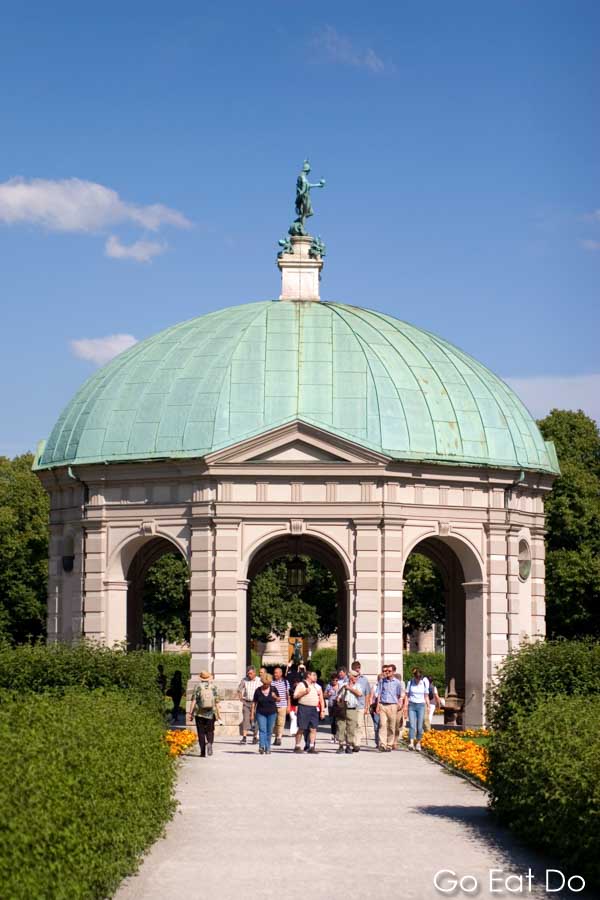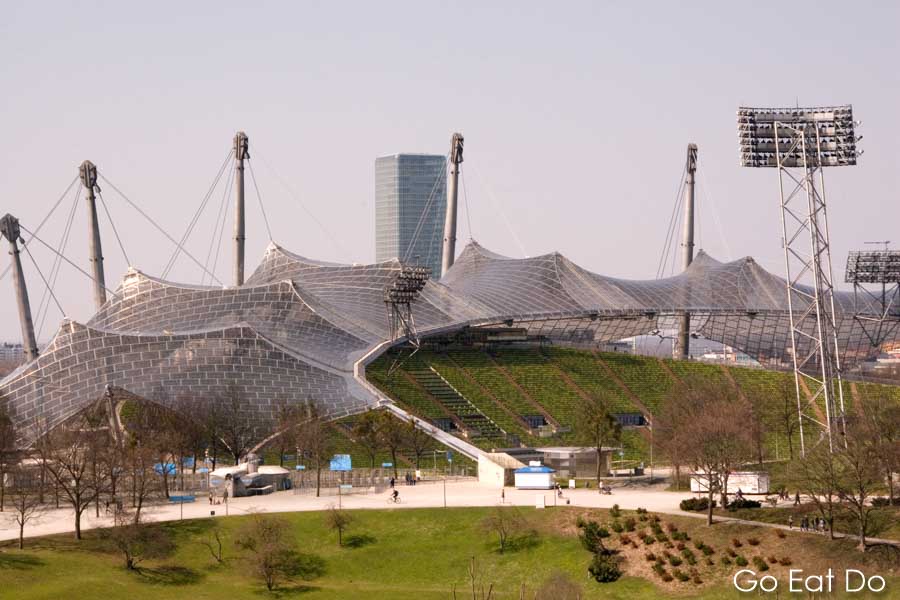Stuart Forster takes a look at some of the best places to visit and top things to do in Munich beyond the Oktoberfest.
Disclosure: Some of the links below and banners are affiliate links, meaning, at no additional cost to you, I will earn a commission if you click through and make a purchase.
Each autumn millions of visitors pour into Munich for the Oktoberfest. The Bavarian capital’s parks, museums and palaces ensure there’s plenty to do if you fancy a break from the beer served at the event that locals call the Wiesn.
Munich has a rich cultural heritage and is pedestrian-friendly. Pack a comfy pair of shoes to explore the city that was long the chief residence of Bavaria’s dukes. From 1805 to 1918 it was the capital of a kingdom.
Origins of the Oktoberfest
The Oktoberfest, which Munich’s residents proudly point out is the world’s biggest Stadtfest (city festival) had its origins as a royal wedding feast marking the union of Crown Prince Ludwig and Princess Therese of Saxony-Hildburghausen.
The meadow on which celebratory horse races were held, back in 1810, was renamed the Theresienwiese in honour of the royal bride. A vast, bronze statue of Bavaria, in female form, now stands there, next to the Ruhmeshalle, the Classical-style hall of fame, lined with marble busts, celebrating the lives of famous Bavarians.

Eat a Weisswurst breakfast
That landmark stands a couple of kilometres west of Marienplatz, the square in front of the ornate façade of the Neo-Gothic city hall that marks the heart of Munich.
Crowds gather at 11.00 am, noon and 5.00 pm for the chiming of the city hall clock and procession of colourful figures, including spinning coopers, dressed in red, whose dance was said to rid the city of plague in 1517.
The vaulted cellars beneath the municipal offices house the Ratskeller restaurant (8 Marienplatz; tel. +49 89 2199 890) which serves warm food throughout the day. Head there before noon to order a pair of Weisswurst sausages and a pretzel. Traditionally they are served with a half-litre of Weissbier (wheat beer). It’s easy to spot visitors to Munich because they clink the rims of glasses together when saying cheers. Locals bump together the bulbous bases of Weissbier glasses.

Visit Germany’s largest urban palace
Germany’s largest urban palace, the Munich Residence, is just a couple of minutes’ walk from Marienplatz. Visiting throws light onto the enormous wealth and power once held by the Wittelsbach family, who ruled over Bavaria for more than 700 years.
Established as a fortress, the Residence evolved and expanded over centuries. The Imperial Hall, built to impress guests at official functions, and the Cuvilliés Theatre, where members of the court would attend operas, encapsulate its enduring grandeur.
One of the highlights is the treasury museum, which displays exquisite examples of work by medieval master goldsmiths and a noteworthy porcelain collection.

A trip to Nymphenburg Palace
Nymphenburg Palace was established as the Wittelsbach’s summer residence in the late 17th century. The Baroque landmark stands within landscaped parkland that is dotted with pavilions, including a hunting lodge that is larger than most modern family homes, and formal gardens with cascading water.
Horse-drawn carriages would once have conveyed courtiers from the city centre, tram number 17 now trundles that route.
One of the notable attractions inside the palace is the Gallery of Beauties. King Ludwig I took it upon himself to select 36 Bavarian women to be immortalised in the oil paintings that are displayed in the gallery.

A stroll in the Hofgarten
One of my favourite city centre spots, especially on fine days, is the Hofgarten close to the city centre. The laying out of the Italian-style garden was completed 400 years ago, during the reign of Maximilian I.
Members of the court would once have perambulated around the symmetrically laid-out garden where visitors now crunch along the gravel.
The acoustics in the Temple of Diana, the domed pavilion at its centre, make the folly a good spot to pause to listen to talented buskers playing extracts from the likes of Mozart and Bach.

Take in an opera
Such works also count among the scores performed at the National Theatre on nearby Max-Joseph-Platz. The building is the home of the Bavarian State Opera and State Ballet companies.
Watch FC Bayern play
One of the things I love about Munich is the accessibility of cultural events and top-level professional sports. FC Bayern play their home fixtures at the 75,000-capacity Allianz Arena, on the city’s northern fringe. The club is Germany’s reigning champions during the 2017-18 season.

A day at the Deutsches Museum
Technically minded visitors can easily spend a full day at the Deutsches Museum. The world’s biggest science and technology museum stands on an island in the River Isar.
Exhibits include aircraft, motor vehicles and computing equipment. Throughout the day a series of demonstrations are held, including on how lightning strikes occur and the workings of a Faraday cage.
BMW Museum and BMW Welt
The acronym BMW stands for the German equivalent of ‘Bavarian Motor Works’. The company was founded over a century ago and its story is told at the BMW Museum.
The nearby BMW Welt showcases the company’s latest vehicles, including Rolls-Royce and Minis. Owners take delivery of their new vehicles within the state-of-the-art building. EssZimmer, the restaurant up on the third floor, holds the accolade of two Michelin stars and serves cuisine by chef Bobby Braeuer and his team.

Zip-lining in Munich’s Olympic Park
The Olympic Park, built to host the 1972 Olympic Games, stands within walking distance of BMW Welt. For an elevated view of the city and towards the Alps, head 190 metres up to the observation platform in Olympic Tower.
Look down and you may see people abseiling and walking on the tent-style roof of the Olympic Stadium, which was also the venue of the 1974 World Cup Final. One of the best adrenaline rushes in the city is on the zip line leading from the stadium roof.

An evening in Schwabing
For an evening drink or a bite to eat, grab a seat on one of the terraces of cafes and restaurants in the chic Schwabing district of the city. Sitting outdoors allows you to watch people milling along Leopoldstrasse, the broad street that leads southwards to Odeonsplatz and the city centre.
If you have the energy and can manage a few more steps before turning in for the night, it’s worth viewing the illuminated Siegestor as darkness falls. The triple-arched landmark commemorates the end of the Napoleonic Wars and is, in every sense, a triumphal place to end a day in Munich.

Where to eat in Munich
Wirthaus in der Au (Lillienstrasse 58; tel. +49 89 4481 400) is a cosy, traditional Bavarian tavern in the Au district of the city. Waitresses wearing Dirndl dresses deliver hearty dishes such as dumplings plus roast duck served with red cabbage and potatoes.
Schuhbecks in der Suedtiroler Stuben (Platzl 6-8; tel.+49 89 2166 900) is a stylish, fine-dining restaurant with a Michelin star on Platzl square, close to the Hofbraeuhaus. Chef Alfons Schuhbeck and his team serve seasonal Bavarian-Mediterranean creations.

Further information
Discover more on the Munich website. The Bavaria and Germany tourism websites also have information about the city and nearby attractions.
Stuart Forster, the author of this post, lived in Munich for four years and visits the city frequently.
Thank you for visiting Go Eat Do and reading this post outlining the top things to do in Munich. Interested in visiting the region? July is ideal for watching jousting and jesters at the Kaltenberg Ritterturnier.
Photos illustrating this post are by Why Eye Photography.
If you enjoyed this post, please sign up for the free Go Eat Do newsletter.? It’s a hassle-free way of getting links to posts once a month
‘Like’ the Go Eat Do Facebook page to see more photos and content.




